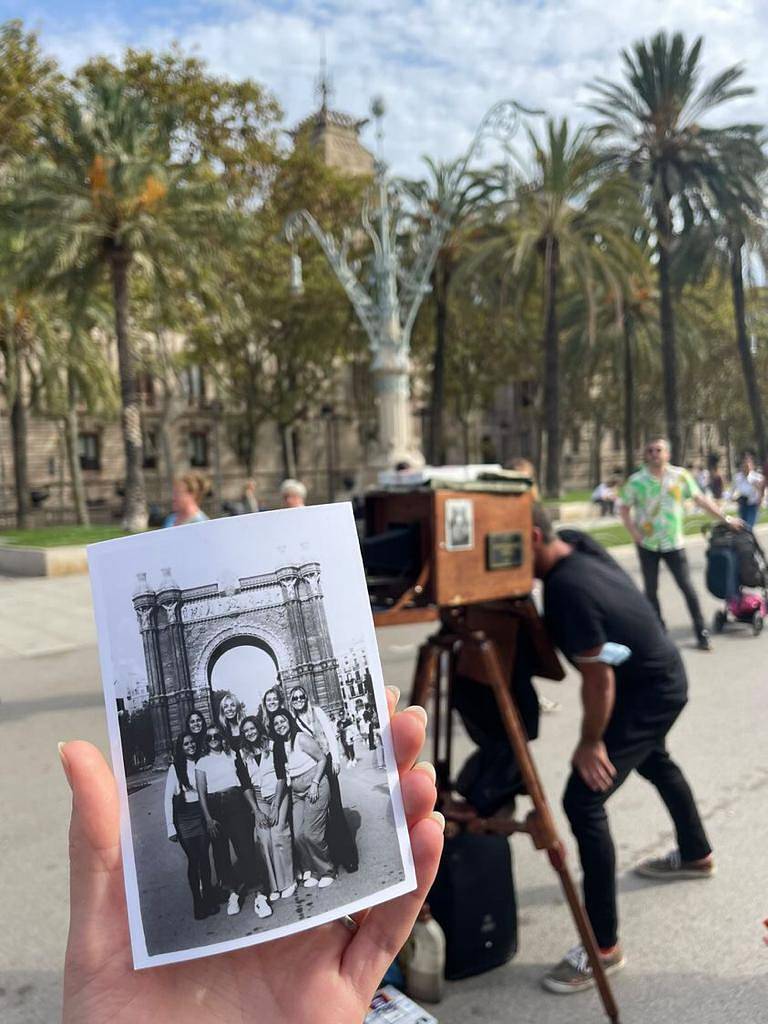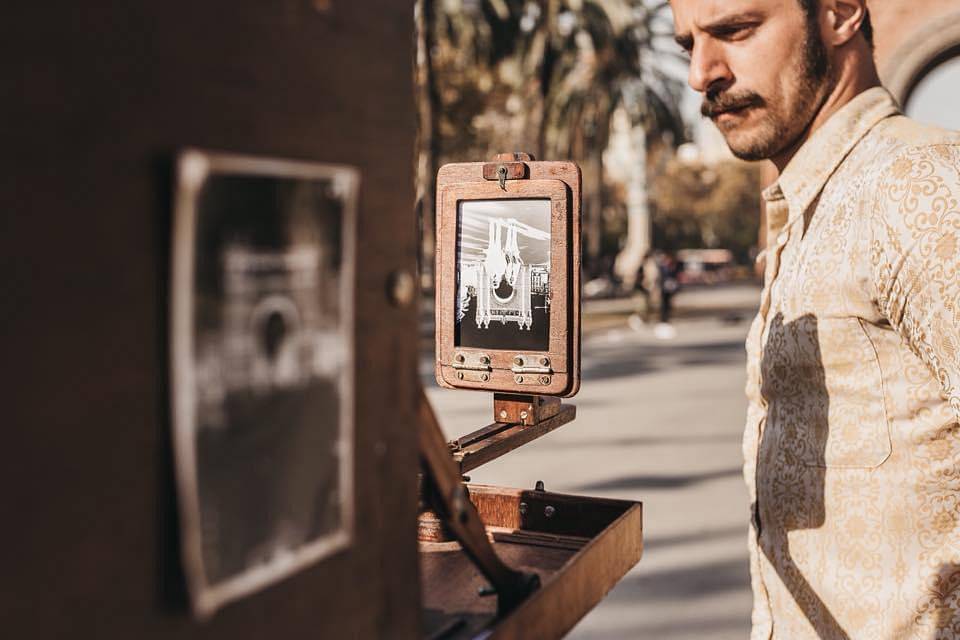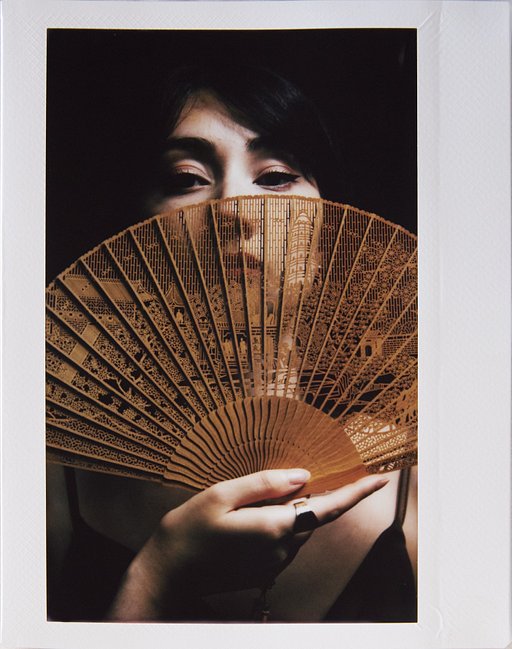Large Format Portrait Photography on the Streets of Barcelona
5 19 Share TweetWhile visiting Barcelona, I saw a beautiful large format camera standing on the promenade in front of the Arco de Triunfo. I couldn't help myself, and I went straight toward it. There I saw Maxi, busy working with a couple of girls who were posing for their portrait.
I was immediately intrigued by his work and I was not the only one. The crowd around him was also curious about how it worked, and it was inspiring to see that so many people could recognise the value of Maxi's job. It is proof that people still appreciate a handmade photo, and are amazed by the process which is being kept alive thanks to Maxi and others like him who devote their time and energy to mastering large format photography.
Hello Maxi, welcome to the Lomography Magazine. Can you tell us about yourself, and how you started in photography?
Hello! I was born in La Plata (Argentina) but after only months my family started traveling through different cities and countries. I have been living in Europe for the last 20 years (the last 7 years in Catalonia). My passion for photography is heavily rooted at the end of my adolescence when I started experimenting with my first camera (a Nikon F80).
I didn't really know what I was doing. It was only clear that I really liked to play with the manual mode and make notes on each take and then run off to the lab to see what came out and compare with my notes on each shot and try to understand what I was doing. As the time passed by, I took part in different photographic courses always oriented towards analogue photography and ancient processes and their alchemy.
So you shoot with a large format camera on the streets of Barcelona. Tell us how you got this idea?
The first time I had contact with a large format camera was completely by accident. It was 2012 and I was traveling through Indonesia. I was walking through the streets of Jakarta and there it was, a super dilapidated green camera operated by a man. I think it didn't take me more than 20 seconds to imagine myself with one of those cameras traveling and taking pictures of people in the streets.
Upon my return to Spain, I got in touch with two photographers (Michi Rodríguez in Tenerife and José Luis in Alicante). The first one gave me some incredible basic lessons and the second one put me in his workshop where we put together my first camera.
I spent tons of boxes of paper to understand a little bit about that fine balance of working with a low ISO orthochromatic material (paper between 4 to 6 ISO) the very low dynamic range, the limitations of centuries old optics, and the variations that can occur due to different temperatures of the chemicals. When I felt comfortable working with it, everything seemed to fall into place.
Being able to make a living developing photographs on the same street while you meet people, and having the freedom to move from one city to another and own your own time was priceless. The rest is travel, lots of it, and amazing memories I created in over 15 countries until I finally ended up in Barcelona.
What is the response from tourists when they see you with your camera?
I work with both locals and tourists, although local people are present mostly on weekends. The impression people get when they see the camera is utterly surprising. Nowadays, where we all have a camera in the form of a smartphone in our pocket, the contrast is enormous! In addition to that, analogue photography is often a completely foreign field for younger people so I have a lot of fun explaining how light works and how it can be captured through photosensitive materials and developed. They often approach, they ask questions, they take pictures of the camera etc. It is true that sometimes it is somewhat complex to create a piece with 80 eyes watching every move I make, but even so, I enjoy it very much.
What is your developing process that allows you to give people a picture right away? And what is their reaction?
It could be said that the process is quite basic (obviously removing all the variables and details that end up making it somewhat complex). I use a late 20s bellows camera. Inside the drawer there are basically four things. A frosted glass where the light is projected and the scene to be photographed is composed, moving forwards and backwards through a reel system, a small box where I keep the photosensitive paper, two chemicals, developer and fixer, and a black cloth at the end part of the box.
First I compose the image and focus on the models with my head up the camera sleeve. Once the image is adjusted, I close the lens and put my hand up the sleeve (the box is in complete darkness and this allows me to open the box of photosensitive papers and place the paper just in front of the focusing glass.
The next step is (sometimes) done by using the shutter, but many other times I simply open the lens cover and let the light through for the necessary time with the shutter in bulb mode. The next thing is to pass the paper through the developer and then through the fixer. At that moment I can take the first photograph out of the box already fixed for washing, and there we have a negative.
Once the negative has been cleaned of chemicals, I have a piece that you can better appreciate in the photos accompanying this interview, that allows me to place this negative perpendicular to the objective. The reason why the negative is placed in this piece is simply because the second part of the process consists of printing this first negative. If we have a negative and we photograph it, we will invert the gray scale and have a positive (negative plus negative, positive.)
Let's say that the bow, the bellows and the lens would be a kind of inverted enlarger in which instead of passing light through a negative and projecting it on a virgin paper (which we usually do in a dark room) the light enters through the lens and creates the image inside the box. So once the negative is placed in front of the lens we practically repeat the process again.
This time I focus on the negative in the frame. I close the lens, I put a new piece of paper back on, I make the exposure and I develop again. Then fix and wash with water at the end. All this process is carried out in five to seven minutes, which makes the technique one of the fastest when it comes to manual analogue processes.
What a fascinating process! Do you use other analogue cameras as well?
All the cameras I have are analogue. At first I collected more than I actually put in use and now I basically get by with very few. I try to test more new lenses rather than cameras. The ones I use the most are a Nikon FM2n and a Nikon F. I also occasionally take out a Pentacon six (medium format). Then I also have some Lomography cameras: Lomo LC-Wide, La Sardina and lately I've been playing a lot with the Oktomat, an 8-lens camera, together with my daughter.
What's coming up for you in the future?
I am involved in many things at the same time although the upbringing of my daughter puts time in a different perspective.
On the one hand I am trying to finish controlling an analogue technique to photograph in color with my Street Box Camera. It is an amazing process that I would be more than happy to share more about later on. On the other hand, I have been experimenting for years with the color technique called Autochrome created by the Lumiere brothers in the early 1900s.
Lastly, I am working with a violin luthier who works wood exquisitely to release high-quality, easy-to-use Street Box Camera for sale and thus be able to bring this incredible technique to more people. We already have two prototypes created and we only need a little time to announce it and start it up, hopefully by the end of this year. Greetings to all and I invite you to come to the Arco de Triunfo in Barcelona to get to know the technique up close. I will be happy to explain how it works.
If you are in Barcelona be sure to stop by at the Arco de Triunfo and meet Maxi, in the meantime, you can follow his work here.
This article was updated on the 6-4-2023 for clarification purposes.
written by eparrino on 2023-03-28 #culture #people #barcelona #spain #large-format #afghan-box-camera





































5 Comments